#taposiris magna
Explore tagged Tumblr posts
Text
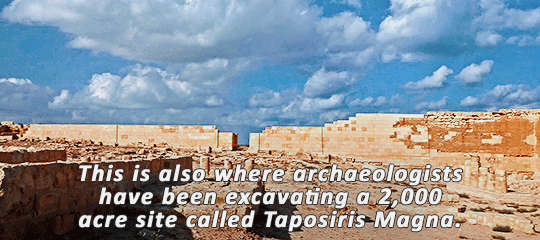
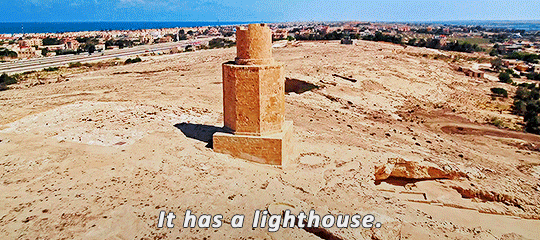
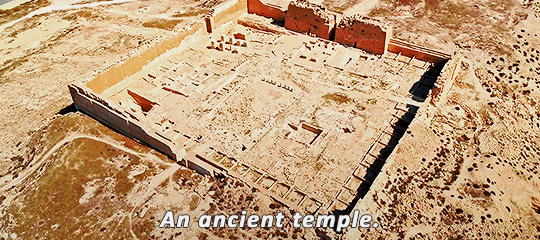
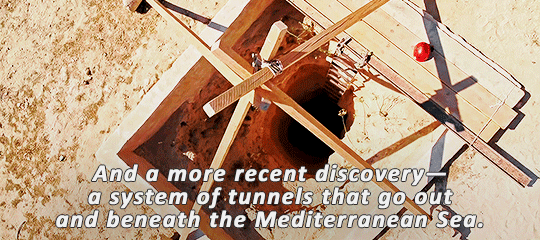
ANCIENT EGYPT BY TRAIN (2023) — 1.01 Alexandria
#egypt#ancient egypt#egyptology#archaeology#historyedit#documentary#gifsbyancientegyptdaily#doc: ancient egypt by train#2023#alexandria#taposiris magna
481 notes
·
View notes
Text

Possible Bust of Cleopatra VII Found at Ancient Egyptian Temple
A small statue of a woman wearing a royal crown may depict Cleopatra VII, an archaeologist claims. Other archaeologists think it is likely someone else.
A small statue discovered under a temple wall at the site of an ancient Egyptian city may depict Cleopatra VII, the Egyptian queen who romanced Julius Caesar and Mark Antony, according to the archaeologist who is leading excavations at the site, known as Taposiris Magna. However, other archaeologists think the bust likely represents someone else.
The white, marble statue — which is small enough to fit in a person's hand — shows a female wearing a royal crown. Kathleen Martinez, an archaeologist who leads the Egyptian-Dominican team that is excavating the site, believes the statue depicts Cleopatra VII, according to a translated statement from the Egyptian Ministry of Tourism and Antiquities. Cleopatra VII (lived from 69 to 30 B.C.) was the last ruler of the Ptolemaic dynasty, which started when Ptolemy I Soter, one of Alexander the Great's generals, started ruling ancient Egypt in 305 B.C.

However, other archaeologists do not believe the bust depicts Cleopatra VII, the statement said, noting that the statue may represent a princess or another royal woman. Zahi Hawass, a former Egyptian minister of antiquities who was not involved in the finding but has excavated at the site in the past, said he thinks the bust dates to after Cleopatra's time.
"I looked at the bust carefully. It is not Cleopatra at all; it is Roman," Hawass said in an email. During the Ptolemaic dynasty, pharaohs were portrayed with Egyptian, not Roman, art styles. The Roman period in Egypt began in 30 B.C. after Cleopatra's death. Her tomb has never been found.
Taposiris Magna was a city founded around 280 B.C. near the Mediterranean Sea; it had a number of temples dedicated to Osiris and Isis, among other deities. A fragment of another bust depicting a king wearing the "Nemes" — a headdress that goes over the head and down to the shoulders — was found near the female bust at the temple in Taposiris Magna, the statement said. It's unclear which king this depicts, however.
Archaeologists also unearthed 337 coins, many of which depict Cleopatra VII, near the busts. In addition, they found a variety of other artifacts, such as oil lamps; a bronze ring dedicated to Hathor, a sky goddess associated with fertility and love; and an amulet engraved with the phrase "The justice of Ra has arisen." (Ra was the sun god.)
By Owen Jarus.



#Possible Bust of Cleopatra VII Found at Ancient Egyptian Temple#Cleopatra#Kathleen Martinez#Taposiris Magna#marble#marble statue#marble sculpture#ancient coins#ancient artifacts#archeology#archeolgst#history#history news#ancient history#ancient culture#ancient civilizations#ancient egypt#egyptian history#egyptian art
36 notes
·
View notes
Text
A controversial find. Any time someone says anything about Cleopatra VII, it tends to be controversial, even if it's relatively benign.
4 notes
·
View notes
Text


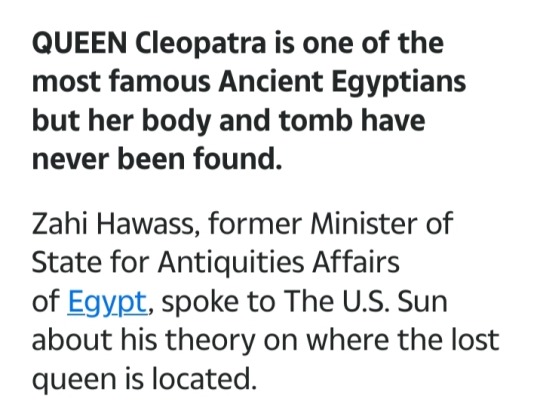

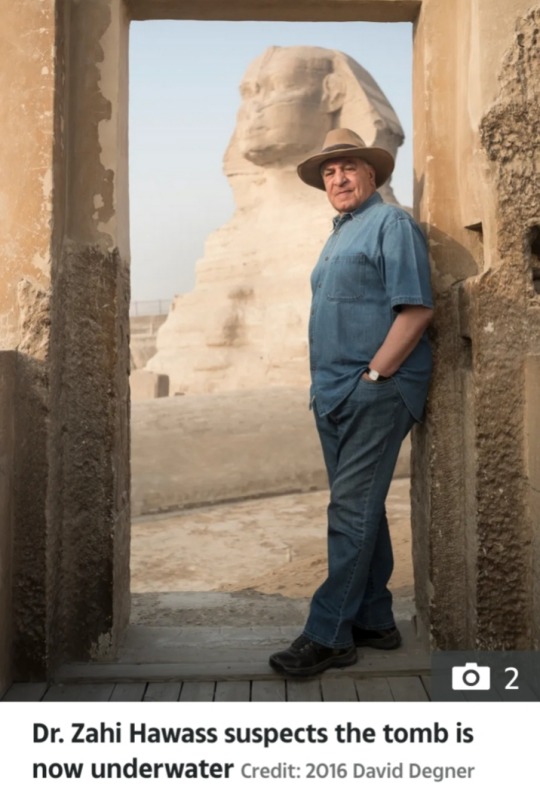
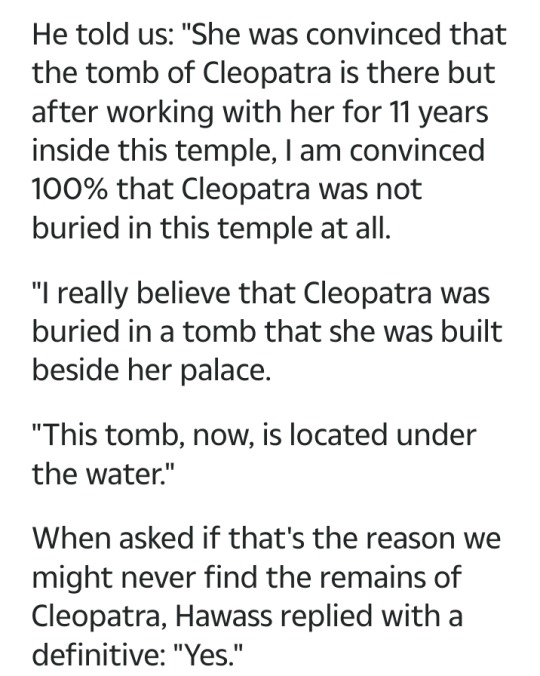


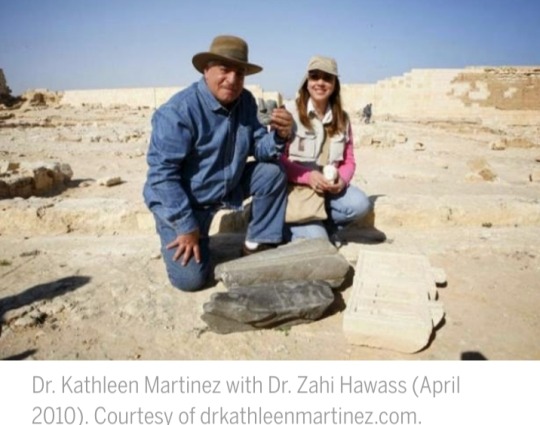
#Queen Cleopatra#Cleopatra#Ancient Egypt#Cleopatra's Tomb#Taposiris Magna#Dr Zahi Hawass#Antiquities Affairs of Egypt#Dr Kathleen Martínez#Mark Antony#Octavian#Augustus#Alexandria#egyptology#archaeology#lost tomb#tomb#Ancient Civilization
9 notes
·
View notes
Text

The Mummy with the Golden Tongue
The Mummy with the Golden Tongue was discovered in early 2021 at the Taposiris Magna temple, west of Alexandria, by a team of Egyptian and Dominican archaeologists, led by Dr. Kathleen Martínez, who has been searching for the lost tomb of Cleopatra.
The mummy is that of a woman, and the burial style and artefacts surrounding this woman’s burial suggest she was interred during a time when Egyptian and Greco-Roman cultural influences blended, creating a period when traditional Egyptian burial customs were still practiced alongside Greek and Roman influences. Thus, it is believed she lived sometime during the Ptolemaic – Greco-Roman Period.
Due to the poor state of preservation, archaeologists could not determine her name, status, or cause of death. However, the presence of the golden tongue suggests she may have been a person of some importance, and at the very least, she was somebody connected to wealth who could afford an elaborate burial. Considering the burial was at the site of a temple, which would have had significant religious and political importance, this could mean the woman was a priestess or had connections to the temple, but as yet, that is unknown and just an educated guess.
Why did she have a golden tongue?
In Egyptian religious texts, gods are described as having golden skin, silver bones, and lapis lazuli hair. Many temple reliefs and statues depict deities with golden-toned bodies, emphasizing their divine nature. Unlike other metals, gold does not rust or deteriorate over time. The Egyptians saw this as a symbol of the gods’ immortality and divine essence. This belief influenced burial customs.
As is common knowledge, Ancient Egyptians believed in preparing the dead for the Afterlife. The golden tongue amulet and or foil was therefore most likely placed in the mummy’s mouth to allow the deceased to speak beyond death, specifically to the deities of the Underworld, especially the ruler of the Underworld, the god Osiris. The golden tongue would, therefore, adorn her speech, and allow her to speak up with a “golden” and divinely inspired confidence during the judgment of her soul, preserving her with a safe passage to the heavenly realm, known to the Egyptians as the “Field of Reeds”.
Read full article here
126 notes
·
View notes
Text

A female mummy encased in a cartonnage
from tombs found at Taposiris Magna,
modern day Abusir, Egypt
Cartonnage is the term used in Egyptology and Papyrology naming a method used in funerary processes to produce cases, masks, or panels to help cover all/part of mummified or wrapped bodies
#art#archaeology#mummy#egypt#ancient art#ancient egypt#egyptology#ancient culture#ancient kemet#kemetic#kemet#egyptian art#papyrus#papyrology#cartonnage#mummification#mummified
794 notes
·
View notes
Text
Ancient Post-Life Drip - 2,000 year old golden-tongued mummy discovered in the temple of Taposiris Magna in Egypt.Embalmers perhaps placed the golden tongue in the mummy to ensure that the deceased would be able to speak in the afterlife.

9 notes
·
View notes
Text

Vista norte del templo de Osiris de Taposiris Magna
9 notes
·
View notes
Text
Descubrimiento de la cabeza ptolemaica en Taposiris Magna en Alejandría
La misión arqueológica francesa, dirigida por el Dr. Joachim Le Bomin de la Universidad de Lyon y el Instituto Francés de Arqueología Oriental en El Cairo, hizo un descubrimiento increíble en Taposiris Magna, a unos 45 km al oeste de Alejandría. Descubrieron una cabeza de estatua de mármol de un anciano, que se cree data del período ptolemaico. Este sitio, rico en historia, es un punto destacado para cualquiera que explore Viajes a Egipto y ofrece perspectivas únicas sobre la importancia antigua de la región.
El Ministro de Turismo y Antigüedades de Egipto, el Sr. Sherif Fathy, anunció el descubrimiento. El Dr. Mohamed Ismail Khaled, Secretario General del Consejo Supremo de Antigüedades, reveló que la cabeza mide 38 cm de altura, lo que la hace más grande que una cabeza humana natural. Esto sugiere que era parte de una estatua monumental ubicada en una estructura pública significativa, posiblemente un templo, añadiendo una capa enriquecedora a Egipto Tours Clásicos, que se centra en la historia antigua.
El profesor Mohamed Abdel-Badie, jefe del sector de antigüedades egipcias, explicó que la cabeza exhibe una artesanía excepcional, reflejando el estilo artístico realista que floreció durante el período helenístico tard��o. Las características detalladas representan a un hombre anciano, calvo, con arrugas, una expresión severa y signos de enfermedad. Este descubrimiento aumenta el atractivo de Excursiones de un día a Egipto, especialmente para aquellos con interés en la arqueología.
Los estudios indican que la persona representada era una figura pública prominente, en lugar de realeza, subrayando la importancia de Taposiris Magna como un sitio político y religioso clave durante el reinado de Ptolomeo IV. Esta importancia lo convierte en una adición esencial a cualquier paquete de tours por Egipto.
El Dr. Joachim Le Bomin declaró que la misión está investigando activamente por qué la cabeza de la estatua fue encontrada en una casa construida alrededor de 700 años después de la creación de la cabeza. Los esfuerzos en curso incluyen el estudio del artefacto para identificar a su propietario y realizar la restauración necesaria. Los visitantes de Excursiones de un día a Egipto desde El Cairo pueden maravillarse con la historia estratificada del sitio y disfrutar de su intrigante mezcla de influencias griegas, romanas y bizantinas.
El sitio de Taposiris Magna es una de las paradas más importantes en Viajes de Pascua a Egipto, especialmente dada su importancia religiosa en el mundo antiguo. El sitio incluye el grandioso Templo de Osiris, que le dio a la ciudad su nombre, derivado del término egipcio antiguo "Per Wsir", que significa "Casa de Osiris." La zona también cuenta con el Faro de Abu Sir, que se asemeja al antiguo Faro de Alejandría, y las estructuras circundantes como la iglesia bizantina, las áreas residenciales y los mercados comerciales cerca del Lago Mariout.
La misión francesa ha estado excavando en Taposiris Magna desde 1998, centrándose en áreas como el baño ptolemaico, un baño público único y bien conservado que es una parada fascinante en Excursiones en tierra en Egipto. También están restaurando las Tumbas de Platino y explorando las áreas del sur del sitio, que incluyen un puerto comercial y mercados bizantinos, ofreciendo a los viajeros la oportunidad de descubrir los misterios de esta extraordinaria ubicación.
Para aquellos que buscan una experiencia auténtica del antiguo Egipto, Taposiris Magna es un destino imperdible. Complementa perfectamente una variedad de Tours por Egipto, desde exploraciones históricas hasta paquetes personalizados que dan vida al increíble pasado del país.

0 notes
Text
Una enorme cabeza de mármol de una estatua monumental de época ptolemaica, encontrada en una casa medieval de Taposiris Magna
0 notes
Text
Seventh-century Ptolemaic head uncovered at Taposiris Magna in Alexandria, Egypt
1/18/2025
The French archaeological mission from the University of Lyon and the French Institute for Oriental Archaeology in Cairo, led by Dr. Joachim le Bomin, has successfully uncovered a marble head of an elderly man from the Ptolemaic period. The discovery was made among the ruins of a 7th-century AD house during the mission's excavations at the site of Taposiris Magna, 45 kilometers west of Alexandria.
This announcement was made by Mr. Sherif Fathy, Minister of Tourism and Antiquities.
Dr. Mohamed Ismail Khaled, Secretary-General of the Supreme Council of Antiquities, explained that the large size of the discovered head, which measures about 38 cm in height—larger than a natural human head—indicates that it was part of a colossal statue in a significant public building rather than a private house.
Prof. Mohamed Abdel-Badea, Head of the Egyptian Antiquities Sector at the Supreme Council of Antiquities, noted that the discovered head was sculpted with high artistic precision and realistic features, characteristic of the realism style of portraiture that flourished at the end of the Hellenistic period.
Preliminary studies of the head's features suggest that it depicts an elderly man with a shaved head, a face full of wrinkles, and signs of sternness and illness.
The studies also revealed that the man was a prominent public figure rather than a king, highlighting the importance of the Taposiris Magna site from the reign of Ptolemy IV onwards.
Dr. Joachim le Bomin, head of the mission, confirmed that the team continues its work at the site to determine why the head was found in this house, dating back around 700 years before the house was built. He added that the mission team is conducting further studies on the head to identify its owner and has started the necessary conservation and restoration work.
It is worth noting that the Taposiris Magna site is one of the most significant archaeological sites on Egypt's northern coast due to its great sanctity during the Greek, Roman, and Byzantine periods. The site includes a large temple dedicated to the worship of the god Osiris, from which the city’s name, Taposiris Magna, is derived. The Greek name originates from the ancient Egyptian words Per-Osir, meaning "House of Osiris."
The site contains many significant standing monuments, including the Abu Sir Temple, the Plinthine tombs, and the vast necropolis located to the east and west of the temple. It also features the Abu Sir Lighthouse, reminiscent of the ancient Lighthouse of Alexandria. The area’s name, Borg El-Arab, derives from the presence of this lighthouse or tower. Additionally, the site includes residential areas, the port, commercial structures, and the Byzantine church near the shore of Lake Mariout.
The French Institute for Oriental Archaeology has been conducting excavations at Taposiris Magna since 1998, carrying out restoration and excavation activities in various site areas. These include the Ptolemaic bath area, notable for its unique design and excellent preservation, the Plinthine tombs, dating back to the Ptolemaic period, and the southern area overlooking Lake Mariout, which encompasses the commercial port, houses, and Byzantine markets.
Our Egypt Tours offers an unforgettable journey through the heart of history, allowing you to explore ancient wonders such as the Great Pyramids of Giza, the Sphinx, and the majestic temples of Luxor and Karnak. Dive into the vibrant culture with Nile cruises, bustling bazaars, and authentic Egyptian cuisine.
Also, if you're staying for a long period in Egypt. Our Egypt Travel Packages are designed to provide a seamless experience, combining adventure, relaxation, and discovery. From guided tours of historical landmarks to leisure stays at Red Sea resorts like Sharm El-Sheikh and Hurghada, these packages cater to diverse interests and budgets.
in addition, our Egypt Classic Tours focuses on the timeless treasures of Egypt, taking you to iconic sites that shaped ancient civilization. Walk through the Valley of the Kings, marvel at the temples of Abu Simbel, and sail the legendary Nile River, immersing yourself in the splendor of a bygone era.
So, you can book Cairo and the Nile by Air 8 Days, 7 Nights in Egypt to discover the best of Egypt with the Cairo and the Nile by Air package, an 8-day, 7-night journey blending history, culture, and luxury. Perfect for travelers eager to explore iconic landmarks and enjoy a seamless travel experience.
Cairo Your journey starts at Cairo – the largest and most populous city in Egypt. Last but not least, see the ancient world heritage – the Great Pyramids of Giza and the Sphinx; get aquatinted with the most important Egyptian Museum; and, finally, feel the atmosphere of Embaren’s Khan El Khalili. Explore the fascinating locations and discover the historical and contemporary appeal of Cairo area on the guided tour.
Nile Cruise by Air Choose a Nile cruise starting from Luxor; this cruise will take you on a luxury cruise through the Nile which passes through the old world of Egypt. Awe is invoked by visits to the Temples of Karnak and Luxor, and get astonished by the fascination of the Valley of the Kings; pay a visit to world-renowned Temple of Queen Hatshepsut. While cruising towards Aswan the attractions include the Temple of Philae, The Unfinished Obelisk and the High Dam.
Why Choose This Package? This package encompasses the liveliness of Cairo together with the Nile, the historical landmarks of Egypt with its new flavors. Since the flights are incorporated, it is perfect for individuals who want to save as much time and be as comfortable as possible.
0 notes
Text

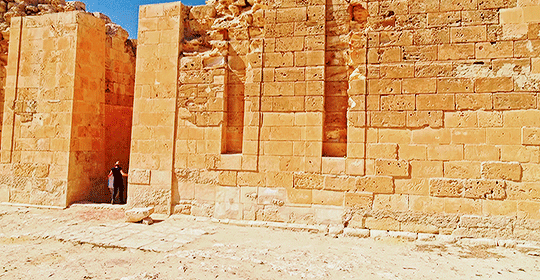
ANCIENT EGYPT BY TRAIN (2023) — 1.01 Alexandria
Taposiris Magna is a city established by Pharaoh Ptolemy II Philadelphus between 280 and 270 BCE. The name means "great tomb of Osiris", which Plutarch identifies with an Egyptian temple in the city.
#egypt#ancient egypt#egyptology#archaeology#historyedit#documentary#gifsbyancientegyptdaily#doc: ancient egypt by train#alexandria#taposiris magna#2023
200 notes
·
View notes
Text

Marble Statue Head Unearthed in Egypt
A French archaeological mission, led by Dr. Joachim Le Bomin from the University of Lyon and the French Institute of Oriental Archaeology in Cairo, has unearthed a large marble head during excavations at Taposiris Magna.
Taposiris Magna was founded by Pharaoh Ptolemy II Philadelphus between 280 and 270 BC in present-day Alexandria Governorate, Egypt.
Taposiris Magna was designed with a square-shaped enclosure centred around a grand temple dedicated to the god Osiris, from which the city’s Greek name, Taposiris Magna, is derived—originating from the ancient Egyptian words Pr-Wsir, meaning “House of Osiris.”
The marble head dates from the Ptolemaic period and was found within the ruins of a 7th century dwelling. According to experts, it depicts an elderly man and once belonged to a colossal statue likely housed in a grand public building.
Measuring approximately 38 cm’s in height, the head exhibits realistic facial features intricately carved in a style typical of the late Hellenistic period.
Dr. Joachim Le Bomin noted that the team is currently investigating why the head was discovered in a house that predates it by approximately 700 years. Further studies are underway to determine the identity of the depicted individual.
This recent discovery follows on from another statue head found in late 2024 that experts believe may depict Cleopatra VII, in addition to a necropolis with 20 catacombs, and traces of a Greek temple from the 4th century BC.
By Mark Milligan.

#Marble Statue Head Unearthed in Egypt#Taposiris Magna#Pharaoh Ptolemy II Philadelphus#marble#marble statue#marble sculpture#marble head#ancient artifacts#archeology#archeolgst#history#history news#ancient history#ancient culture#ancient civilizations#ancient egypt#egyptian history#egyptian art#ancient art
24 notes
·
View notes
Text
Archaeologists discovered a Ptolemaic-era statue head in Alexandria's Taposiris Magna.

A French archaeological mission led by Joachim le Bomin, in collaboration with Lyon University and the French Institute of Eastern Archaeology in Cairo. You can travel to Alexandria through EGYPT TRAVEL PACKAGES by choosing your favorite one. discovered a remarkable marble statue head from the Ptolemaic period at the ruins of a 7th-century AD house in Taposiris Magna, 45 kilometers west of Alexandria. Book your tour with EGYPT TRIPS to enjoy your holiday.
The statue head, which stands around 38 cm tall, is larger than life and looks to have been part of a larger monument that was initially put in a prominent political edifice, not a private dwelling. Book your tour now through EGYPT TOUR ITINARIES to spend your perfect holiday. This shows that the statue previously stood in a prominent public edifice, most likely during the Ptolemaic period, when realistic portraiture flourished. Don't miss the big offers through EGYPT CLASSIC TOURS to enjoy. Enjoy the Egyptian vibes by booking 16 Days in Egypt Itinerary to visit all the historical sites.
the size of the skull indicates its significance in public or political life. Book your tour now 11-Day Egypt Itinerary with the best price. Mohamed Abdel Badie, Head of the Egyptian Antiquities Sector at the SCA, stated that the head is beautifully sculpted with extraordinary attention to detail, representing the realistic style that arose in the late Hellenistic period. Book your trip to Egypt with 12 Days Egypt Itinerary to enjoy Alexandria weather.
Joachim le Bomin, chairman of the excavation project, stated that the team would continue to investigate why such a statue head was discovered in a house built centuries after its creation. You can see all the Egyptian statues by booking 18 Days Egypt Tour Package to see those historical places. The team is also conducting additional research to determine the identity of the figure represented, You can visit all those historical sites by booking 17 Days Egypt Tour with the best offers. they will commence restoration and conservation work on the item. Make it an unforgettable holiday by booking Egypt Itinerary 13 days to Egypt. Egypt always seeks for tourism progress by offering the best tours like Egypt Itinerary 15 Days with the best price.
@cairo-top-tours
0 notes
Text
Discovery of a Large Marble Statue Head from the Ptolemaic Period!
French Archaeological Mission Uncovers Remarkable Find in Taposiris Magna
A French archaeological mission working in Taposiris Magna, located 45 km west of Alexandria, has unearthed the marble head of a large statue depicting an elderly man from the Ptolemaic period. The discovery was made in the ruins of what is believed to have been a politically significant building dating back to the seventh century AD. This fascinating site is an increasingly popular highlight for travellers exploring Egypt Classic Tours.
The Ministry of Tourism and Antiquities announced on its Facebook page that the mission, conducted by the University of Lyon and the French Institute of Oriental Archaeology in Cairo, made the discovery during ongoing excavations in the Taposiris Magna area. This site is often included in many tailored Cairo Day Tours , offering visitors insights into ancient history.
According to Mohamed Ismail Khaled, Secretary-General of the Supreme Council of Egyptian Antiquities, the statue's head, measuring approximately 38 cm in height, is significantly larger than a normal human head. This suggests that it was part of a colossal statue placed in a grand public building of political importance rather than a private residence. Such discoveries are a testament to Egypt's rich history, making it a perfect addition to Egypt Easter Tours itineraries.
Mohamed Abdel Badie, head of the Egyptian Antiquities Sector, highlighted the exceptional craftsmanship of the marble head. The piece features realistic traits characteristic of late Hellenistic art, including wrinkles, a stern expression, and signs of illness, indicating that it likely represents a prominent figure of the time, though not a king. This detail adds depth to Egypt Tours, showcasing the artistry of the Ptolemaic period.
Meanwhile, Joachim Le Bomin, the head of the French mission, stated that further research is being conducted to determine why the statue’s head was found in a structure built 700 years after its creation. Restoration work is also underway. Such ongoing discoveries make sites like Taposiris Magna must-see destinations on Egypt Tours Packages or Egypt Shore Excursions, offering visitors unparalleled glimpses into the country’s layered history.
For travellers interested in exploring Alexandria and its surrounding treasures, this site serves as an excellent addition to Egypt Day Tours, providing a mix of ancient intrigue and historical significance.
0 notes
Text
Nuevo descubrimiento de una cabeza ptolemaica en Taposiris Magna, Alejandría

Egipto es conocido por incluir tesoros que datan de la era patria y que puedes descubrir durante Excursiones a Egipto, la misión arqueológica francesa de la Universidad de Lyon y el Instituto Francés de Arqueología Oriental en El Cairo, dirigido por el Dr. Joaquín el Bomin.
Puedes ver el gran descubrimiento después de elegir tu tour de Paquetes de viaje a Egipto, han logrado descubrir una cabeza de estatua de mármol de un anciano de la época ptolemaica, en las ruinas de una casa del siglo VII d.C., durante las excavaciones de la misión en La zona de Taposiris Magna, a 45 km al oeste de Alejandría. Puede explorar la gran e impresionante ciudad de Alejandría durante los viajes económicos a Egipto, verá la ciudad que reúne varias culturas.
Dr. Mohamed Ismail Khaled, Secretario General, explicó que el enorme tamaño de la cabeza de la estatua descubierta, que mide unos 38 cm de altura, es decir, más grande que el tamaño natural de una cabeza humana. Egipto ofrece a sus visitantes una gran oportunidad a través de Egipto y el Paquete Turístico Económico de Crucero por el Nilo para indicar que era parte de una enorme estatua que se encontraba en un gran edificio de importancia política general y no una casa privada.
Cuando elige el paquete turístico económico de El Cairo y Alejandría, puede ver los sistemas políticos del antiguo Egipto y los monumentos de los antiguos egipcios. Con Cairo Top Tours, puede disfrutar de la civilización egipcia en muy poco tiempo durante el recorrido económico de 3 días con escala en El Cairo con guías turísticos profesionales.
Mientras que el profesor Mohamed Abdel Badie indicó que la cabeza descubierta fue tallada con gran precisión artística y tenía rasgos realistas, ya que era el período de la difusión del arte de la fotografía realista que floreció al final de la era helenística. Puede encontrar un magnífico arte tallado en diferentes tipos de piedras durante el recorrido económico de 5 días por El Cairo y Luxor, Egipto, y descubrir cuán inteligentes eran los antiguos egipcios.
Los primeros estudios de las características de la cabeza revelaron que se trataba de un hombre mayor, con la cabeza rapada, el rostro lleno de arrugas y signos de enfermedad. Añadió que los estudios también mostraron que el hombre con la cabeza era una figura pública prominente y no un rey, lo que indica la importancia del sitio de Taposiris Magna desde Ptolomeo IV en adelante. Puede ver los monumentos y artefactos reales y no reales en el Museo Egipcio de El Cairo y el paquete turístico económico de Sharm El Sheikh, déjese sorprender por las piezas egipcias.
Dr. Joachim le Bomin, jefe de la misión, confirmó que la misión continúa su trabajo en el lugar en un intento de averiguar por qué se encontró esta cabeza en esta casa, aunque su historia se remonta a un período anterior a la construcción de la casa, hace aproximadamente 700 años, señalando que actualmente el equipo de trabajo de la misión realiza más estudios sobre la cabeza para intentar identificar a su dueño, además de iniciar los trabajos de mantenimiento y restauración necesarios. En realidad, el mundo sigue sorprendiendo con los nuevos descubrimientos que también puedes ver durante el paquete turístico económico de El Cairo y Hurghada, con la visita a una de las mejores ciudades del Mar Rojo.
Cabe destacar que el sitio de Taposiris Magna es uno de los sitios arqueológicos más importantes de la costa norte de Egipto debido a su gran santidad en las épocas grecorromana y bizantina. Egipto es muy rico en ciudades arqueológicas grecorromanas y bizantinas y también en momias, puedes disfrutar aprendiendo más sobre ellas en el Presupuesto Sirah Condición Brillo Desarrollo en las diferentes ciudades egipcias.
El sitio contiene un enorme templo dedicado al culto del dios Osiris, de cuyo nombre proviene el nombre de la ciudad, Tabu Xeris Magna, que es el nombre griego dado a la ciudad y se deriva de la antigua palabra egipcia Per-Ser, que significa casa del dios Osiris. El sitio contiene muchos monumentos fijos importantes, incluido el Templo de Abu Sir, las Tumbas de Plátano y el enorme cementerio ubicado al oeste y al este del templo, así como el Faro de Abu Sir, que representa un testigo de la forma del antiguo Faro de Alejandría. Puede descubrir estos grandes tesoros en el paquete turístico económico de 5 días a El Cairo durante una de las mejores vacaciones en Egipto.
El nombre de la zona, Burj Al Arab, se debe a la presencia de este faro o torre en el lugar, así como a la zona de viviendas, el puerto, establecimientos comerciales y la iglesia bizantina, que se encuentra cerca del costa del lago Mariout. La misión del Instituto Francés de Arqueología Oriental trabaja en el yacimiento de Taposiris Magna desde 1998. La misión está llevando a cabo trabajos de excavación y restauración en más de una zona dentro de Taposiris Magna, incluida la zona de los Baños Ptolemaicos.
que se considera una de las áreas más importantes de trabajo de la misión porque contiene un baño público que data de la época ptolemaica, que se encuentra en muy buen estado de conservación y tiene un estilo único que no tiene paralelo en Egipto, y las Tumbas Ballantine. , donde la misión está realizando excavaciones y restauraciones.
1 note
·
View note